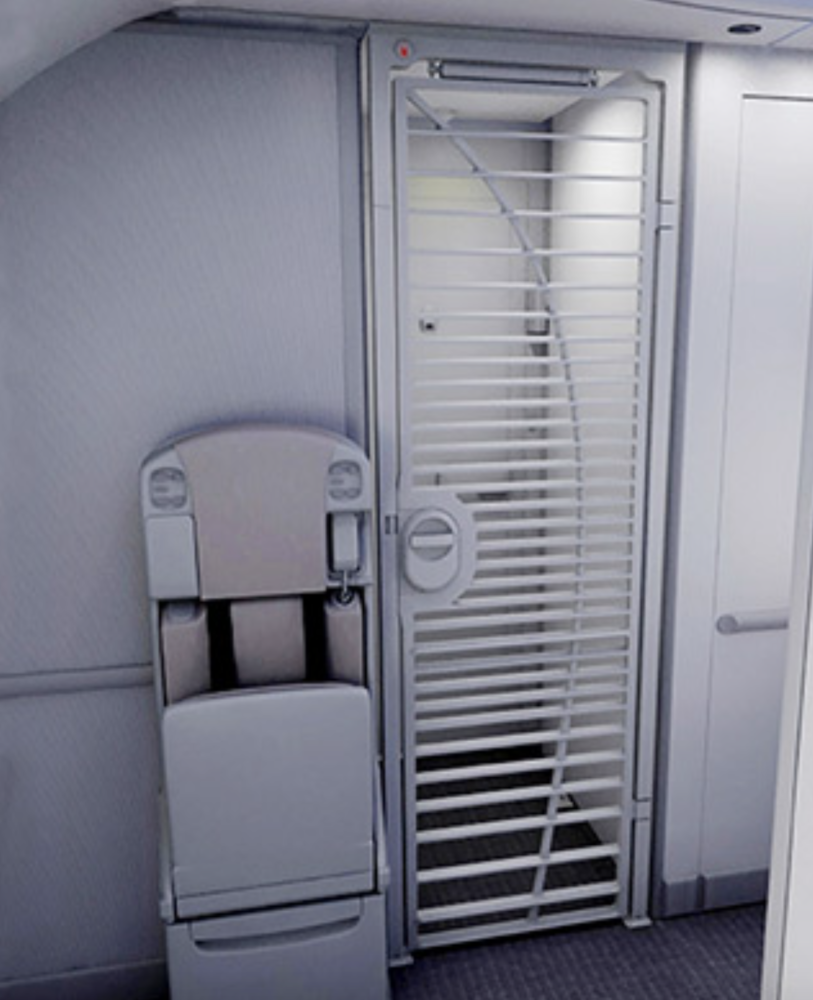The Air Line Pilots Association is pressing the Department of Transportation to get going on requiring “secondary barrier” protection for airliner flight decks. ALPA is hoping for a new rule to be announced by the 20th anniversary of 9/11 terrorist attacks in a few weeks. As part of the 2016 FAA reauthorization, Congress told the agency to make the second layer of defense mandatory on all new aircraft. Some new models of Airbus and Boeing aircraft come with the secondary barriers and there are also retrofits available for existing aircraft. According to Simple Flying, the FAA is studying the matter and has given some advice to proactive airlines on the topic but hasn’t come up with a rule.
The secondary barrier is just that, a backup to the main flight deck door that can be used instead of a flight attendant and a drink cart as a last line of defense for those times when one of the pilots has to leave his or her seat. Congress’s mandate was intended to address the always-present risk of terrorism but the rise in unruly behavior by passengers has added some urgency to the issue. In some cases, passengers have tried to open the flight deck door during their tantrums. In a letter to Transportation Secretary Pete Buttigieg, ALPA President Capt. Joe DePete said the danger of a flight deck breach is increasing. “We learned on 9/11 the vulnerability of the flight deck and are being reminded almost daily that the threats persists despite the FAA’s clear direction from Congress to address it,” he wrote.




































“the FAA is studying the matter and has given some advice to proactive airlines on the topic but hasn’t come up with a rule.”
As we learned from the inability of the FAA to rectify its own screw-up in the simple issue of changing its own policy on Flight Instructors–the FAA Administrator said “4 years” to rewrite it.
The FAA has been (or should have been) “studying the matter” since the first airline hijackers and STILL doesn’t have a policy or recommendation–decades later.
Why would anyone expect “guidance” from an Administration that needs 4 years to fix its own screw-up, and can’t come up with a policy after decades of being aware of the problem?
The flight instruction rule was made by a federal courts decision on what the term ‘commercial’ meant. The problem isn’t just limited and experimental. This wasn’t what the FAA wanted, but it got, because of some non pilot lawyers working in the DOJ.
It is currently unlawful to give a biannual flight review under part 91. It is a commercial operation… think about that for a second…
The FAA never had the authority to define ‘commercial’ yet the entire book of regulations is based on what they decided commercial meant 60 years ago.
Well, off the top of my head, they at least need a procedure to blast the door open in the event of a crash. Otherwise the flight crew might be trapped without an exit.
They call it a “secondary barrier.” The ultimate “secondary barrier” is the Armed Pilot program–allowing certificated and trained pilots to carry a firearm in the cockpit–to be used in the event that a crazy person tries to breach the locked and armored door ( a rare occurrence–has anyone been successful?)
Does anyone have an update on how many pilots have been issued a certificate to do so?
Agreed.
Even a determined Islamic militant does not need too many frangible Corbon .45’s in the face before he loses motivation for mass murder.
Lord I remember the good old days where all a pilot sitting back in 18B had to do was politely ask the flight attendant for a ride in the jump seat. The request would get relayed to the crew and most of the time above 10,000′ I’d be looking out the front rather than the side of the airplane.
I agree. I have a lot more confidence in a trained pilot with a firearm than a “armored door” or TSA person. Not sure I like having 2 barriers to deal with in case of an accident. Really limits crew’s escape options in case a barrier gets jammed closed. Makes me even more glad I did not get into pt121 airline flying. With a secondary barrier how does a flight attendant or a third pilot get into the cockpit when one pilot wants to use the lav. Isn’t it procedure to have at least 2 persons in the cockpit while airborne to prevent what happened in Europe when a pilot locked out the second pilot and deliberately crashed the airplane?
A last defence perhaps? Awkward for pilot to turn around.
Mebbe arm selected F/As, a little pistol in their brassiere? (Well, mebbe in side pocket for guys. :-o)
The passenger compartment needs to be an air tight compartment that the crew can evacuate from and seal off, then pump sleeping gas into when the herd get rowdy.
Would create a vestibule into which F/As could place a cart then lock the outside barrier, pilots can then open the flight deck door to take the food.
On some aircraft, such as Original 737s, the barrier would
Airlines should be acting on their own, can’t depend on gummint which botched security leading up to the Islamic Totalitarian terrorist warrior attacks of September 11, 2001, though airlines also botched. I chronicle clear prior indications and warnings in http://www.moralindividualism.com/prior.htm.
Erps, On some aircraft, such as Original 737s, the barrier would restrict use of forward lavatory, but make use by pilots more secure.
Sounds like a good idea but most gaseous anesthetics are highly flammable and could not be dosed in that manner. Also could be defeated by a gas mask.